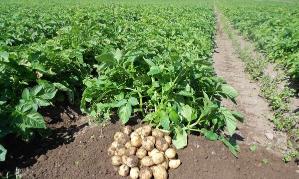 New potato variety which is drought and tolerant to blight./KNA
New potato variety which is drought and tolerant to blight./KNAPotato farmers in Kenya could soon have a more resilient option
against late blight and viral diseases, thanks to a new variety released by
Kalro.
The variety, known as 1G70, was showcased at the ongoing Nairobi
International Trade Fair.
The Kenya Agricultural and Livestock Research Organisation is
showcasing a new potato variety, 1G70, at the Nairobi International Trade Fair.
The variety is highly resistant to late blight and potato virus,
two of the most devastating threats to potato farming.
1G70 is suitable for table consumption, including chips and
crisps. It matures in just four months and has a high yield potential of 35–40
tons per hectare.
The potatoes are oval-oblong in shape with medium-deep eyes and
have cream-white flesh.
According to the National Potato Council of Kenya, potato
farming plays a critical role in the country’s food security and income
generation, especially in counties such as Nyandarua, Nakuru and Meru.
However, for decades, farmers have struggled with limited access
to clean, certified seed, exposing them to low yields and high disease
vulnerability.
“Approximately 800,000 smallholder farmers cultivate potatoes on
296,526–370,658 acres. Together, they produce 1.5 to two million tonnes
annually, which is vital for food security and economic growth. Yet yields
remain significantly below potential,” NPCK says.
Kenya’s average potato yield currently stands at just 7–12
tonnes per hectare, far below the achievable potential of over 40 tonnes.
Pests, seed-borne and soil-borne diseases, and declining soil fertility are
among the biggest challenges. This has left farmers facing a “yield gap” of
more than 20 tonnes per hectare, translating into significant income losses.
NPCK says efforts to address these challenges are underway,
including the dissemination of improved, disease-resistant varieties such as
Sherekea and now 1G70, alongside climate-smart agricultural practices.
The Crops (Irish Potato) Regulations, 2019 were introduced to
streamline the sector by ensuring registration of growers, standardisation in
packaging (a maximum of 50kgs per unit), grading, labeling and quality control.
The potato council says these measures seek to improve industry
standards and protect farmers from exploitation while enhancing market
competitiveness.
“Potatoes contribute significantly to Kenya’s economy, with an
estimated annual market value of Sh50 billion (US$500 million). Yet the
country’s yields remain far below the global average,” the council says.














![[PHOTOS] Family, friends receive body of Raila’s sister, Beryl](/_next/image?url=https%3A%2F%2Fcdn.radioafrica.digital%2Fimage%2F2025%2F11%2Fdfe6a9bf-ede1-47a4-bdc0-4f564edb03dd.jpeg&w=3840&q=100)

